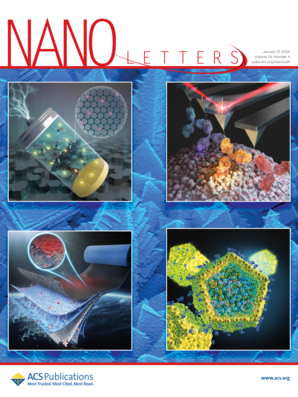利用二维有机分子晶体的原子尺度变薄进行原位表征和优越的光电子学
IF 9.1
1区 材料科学
Q1 CHEMISTRY, MULTIDISCIPLINARY
引用次数: 0
摘要
二维有机单晶(2D OSCs)具有高结晶度和量子极限特性,使其成为探索独特量子相和开发缩放光电器件的理想选择。然而,在二维osc中准确探测结构-光电关系仍然具有挑战性。在这里,我们通过原子精确减薄技术实现二维osc的原位光电表征。将三维并五苯晶体细化到单层极限,诱导了从Frenkel激子到电荷转移(CT)激子的相变,实现了接近单位的量子产率(~ 95.1%)。现场电测量表明,这种细化改善了载流子迁移率并降低了阈值电压。利用二维并五苯晶体,我们构建了一个高性能的突触装置,显示出创纪录的成对脉冲促进指数(PPF指数~ 261%)。这种显著的突触可塑性进一步使我们能够模拟人类视觉系统,以极高的精度(约99.1%)预测物体轨迹。这些结果为二维OSCs的内在特性提供了新的见解,并为多功能光电应用奠定了基础。本文章由计算机程序翻译,如有差异,请以英文原文为准。

Harnessing Atomic-Scale Thinning in Two-Dimensional Organic Molecular Crystals for In-Situ Characterization and Superior Optoelectronics
Two-dimensional organic single crystals (2D OSCs) offer high crystallinity and quantum limit properties, making them ideal for exploring unique quantum phases and developing scaled optoelectronic devices. However, accurately probing the structure-optoelectronic relationship in 2D OSCs remains challenging. Here we realize in situ optoelectronic characterization of 2D OSCs through an atomically precise thinning technique. Thinning 3D pentacene crystals to the monolayer limit induces a phase transition from Frenkel excitons to charge-transfer (CT) excitons, achieving a near-unity quantum yield (∼95.1%). In-situ electrical measurements demonstrate that this thinning improves carrier mobility and reduces threshold voltages. Utilizing 2D pentacene crystals, we construct a high-performance synapse device, showing a record paired-pulse facilitation index (PPF index ∼ 261%). This remarkable synaptic plasticity further allows us to emulate the human vision system, predicting the object trajectory with exceptional accuracy (∼99.1%). These results provide new insights into the intrinsic properties of 2D OSCs and lay the foundation for multifunctional optoelectronic applications.
求助全文
通过发布文献求助,成功后即可免费获取论文全文。
去求助
来源期刊

Nano Letters
工程技术-材料科学:综合
CiteScore
16.80
自引率
2.80%
发文量
1182
审稿时长
1.4 months
期刊介绍:
Nano Letters serves as a dynamic platform for promptly disseminating original results in fundamental, applied, and emerging research across all facets of nanoscience and nanotechnology. A pivotal criterion for inclusion within Nano Letters is the convergence of at least two different areas or disciplines, ensuring a rich interdisciplinary scope. The journal is dedicated to fostering exploration in diverse areas, including:
- Experimental and theoretical findings on physical, chemical, and biological phenomena at the nanoscale
- Synthesis, characterization, and processing of organic, inorganic, polymer, and hybrid nanomaterials through physical, chemical, and biological methodologies
- Modeling and simulation of synthetic, assembly, and interaction processes
- Realization of integrated nanostructures and nano-engineered devices exhibiting advanced performance
- Applications of nanoscale materials in living and environmental systems
Nano Letters is committed to advancing and showcasing groundbreaking research that intersects various domains, fostering innovation and collaboration in the ever-evolving field of nanoscience and nanotechnology.
 求助内容:
求助内容: 应助结果提醒方式:
应助结果提醒方式:


